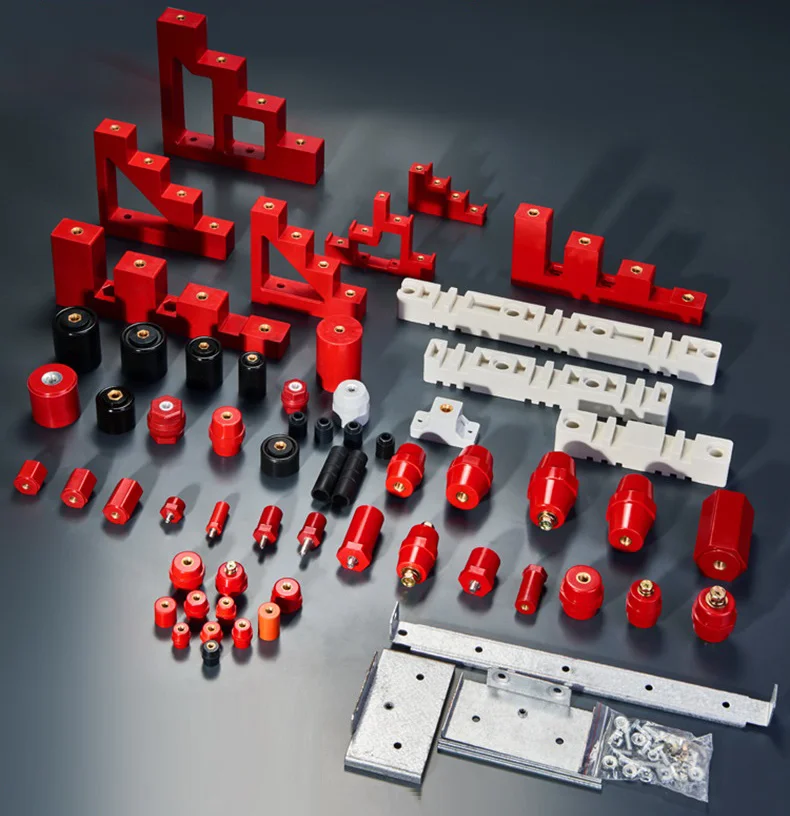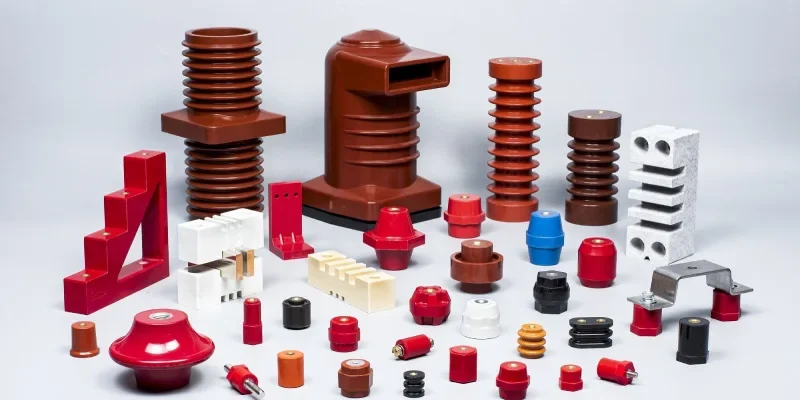Изоляторы сборных шин служат важнейшими компонентами электрических систем, обеспечивая как электрическую изоляцию, так и механическую поддержку токоведущих проводников. Процессы их производства претерпели значительные изменения, чтобы соответствовать требованиям современных сетей распределения электроэнергии, которые требуют высокой надежности, термической стабильности и устойчивости к воздействию окружающей среды. В данном отчете обобщены последние достижения и традиционные методики производства шинных изоляторов с акцентом на выбор материала, технологии производства, контроль качества и экологические аспекты.

Выбор и подготовка материалов
Основные материалы
Изоляторы сборных шин изготавливаются из диэлектрических материалов, оптимизированных по электрическому сопротивлению, механической прочности и термической стабильности. Наиболее распространенные материалы включают:
- Полимерные композиты: Компаунд для объемного формования (BMC) и компаунд для листового формования (SMC), армированный стекловолокном, доминируют в низковольтных и средневольтных приложениях благодаря своей легкости, высокой диэлектрической прочности (~4 кВ/мм) и устойчивости к нагреву (до 140°C).
- Фарфор: Предпочитаемый для высоковольтных наружных установок, фарфор обладает исключительной долговечностью и устойчивостью к атмосферным воздействиям. Для его производства используется высокочистая глиноземная глина, обжигаемая при температуре свыше 1 200°C для получения плотной, непористой структуры.
- Эпоксидные смолы: Эпоксидная смола используется для изоляции шин, обеспечивая надежную изоляцию и защиту окружающей среды. Современные составы включают кремнеземные наполнители для повышения теплопроводности и уменьшения несоответствия КТЭ (коэффициента теплового расширения).
- Термопласты: Такие материалы, как полифениленсульфид (PPS) и полиамид (PA66), все чаще используются в литых изоляторах для высокотемпературных применений (до 220°C) в электромобилях и системах возобновляемых источников энергии.
Подготовка материалов
Сырье проходит тщательную предварительную обработку:
- Полимерные композиты: Гранулы BMC/SMC предварительно нагреваются до 80-100°C для снижения вязкости перед формованием. Содержание стекловолокна (20-30% по весу) оптимизировано для обеспечения механической прочности.
- Фарфор: Глина, каолин, полевой шпат и кварц измельчаются до размера <100 мкм, смешиваются в точном соотношении и экструдируются в заготовки. Для повышения устойчивости к загрязнению на них наносятся глазурные составы (например, коричневый RAL 8016 или серый ANSI 70).
- Эпоксидная смола: Двухкомпонентные системы (смола + отвердитель) дегазируются под вакуумом для удаления пузырьков воздуха, что обеспечивает однородность изоляционных свойств.
Производственные процессы
1. Компрессионное формование
Шаги:
- Подготовка формы: Стальные формы нагреваются до 150-180°C.
- Загрузка материала: Предварительно взвешенные заряды BMC/SMC помещаются в полость формы.
- Сжатие: Гидравлические прессы прикладывают усилие в 100-300 тонн, отверждая материал за 2-5 минут.
- Распаковка и отделка: Изоляторы выталкиваются, зачищаются и подвергаются поверхностной обработке (например, силиконовое покрытие для защиты от ультрафиолета).
Приложения: Низковольтные шестигранные изоляторы (высота 16-70 мм) со вставками из латуни или оцинкованной стали.
2. Литье под давлением
Шаги:
- Подготовка сборных шин: Медные или алюминиевые проводники штампуются, покрываются (оловом, никелем) и очищаются.
- Сборка пресс-формы: Проводники размещаются в многогнездных пресс-формах с помощью роботизированных манипуляторов, обеспечивающих точность (допуск ±0,1 мм).
- Инъекция смолы: Термопласты (например, PA66, PPS) впрыскиваются при температуре 280-320°C и давлении 800-1 200 бар, образуя бесшовный изоляционный слой.
- Охлаждение и выброс: Каналы охлаждения поддерживают температуру пресс-формы на уровне 80-100°C, а время цикла составляет 30-90 секунд.
Преимущества:
- Позволяет создавать сложные геометрии (например, J-образные формы, многоуровневые коннекторы).
- Автоматизированные производственные линии обеспечивают выход >99,5% и производительность 500-1000 единиц в час.
3. Ламинирование высоковольтных изоляторов
Шаги:
- Укладка слоев: Чередующиеся проводящие (медь) и изолирующие (препрег) слои выравниваются с помощью систем лазерного наведения.
- Применение клея: Отверждаемые эпоксидные или акриловые клеи распыляются/накатываются на слои (покрытие: 50-80 г/м²).
- Прессование: Нагретые плиты (150-200°C) прикладывают давление 10-20 МПа в течение 30-60 минут, скрепляя слои при минимальном образовании пустот (<0,5%).
Контроль качества и тестирование
Электрические испытания:
- Диэлектрическая прочность: Изоляторы выдерживают 2,5-4-кратное номинальное напряжение без пробоя.
- Частичный разряд (ЧР): Допустимый уровень <5 pC при напряжении 2,55 кВ.
Механические испытания:
- Консольная нагрузка: Фарфоровые изоляторы A20/A30 выдерживают статические нагрузки 8-12 кН.
- Термоциклирование: от -40°C до +130°C в течение 50 циклов без образования трещин.
Экологические и экономические соображения
Инициативы в области устойчивого развития:
- Полимеры на биооснове: PA66, полученный из касторового масла, снижает углеродный след на 40%.
- Переработка: Фарфоровые изоляторы измельчаются в щебень для дорожного строительства, что обеспечивает возможность вторичной переработки 95%.
Факторы, определяющие затраты:
- Медь составляет 60-70% от стоимости изоляции шин, что побуждает к замене ее на алюминий в слаботочных системах.
- Автоматизированное литье под давлением снижает трудозатраты до <10% от общих расходов.
Заключение
Производство шинных изоляторов объединяет в себе материаловедение, точное машиностроение и строгий контроль качества для удовлетворения меняющихся требований глобальной электрификации. Традиционные методы, такие как компрессионное формование, остаются преобладающими для низковольтных применений, в то время как передовые технологии, такие как формование со вставкой и ламинирование керамическим препрегом, решают проблемы, связанные с высоким напряжением и высокими температурами. Инновации в области аддитивного производства и материалов на биологической основе обещают еще больше повысить устойчивость и эксплуатационные характеристики. По мере расширения рынков возобновляемых источников энергии и электромобилей производители должны находить баланс между экономичностью и необходимостью в изоляторах, обеспечивающих непревзойденную надежность в различных условиях окружающей среды. Будущие исследования должны быть направлены на создание композитов с применением нанотехнологий и оптимизацию процессов на основе искусственного интеллекта, чтобы расширить границы характеристик изоляторов.
Связанный блог
Производитель изоляторов для шин


